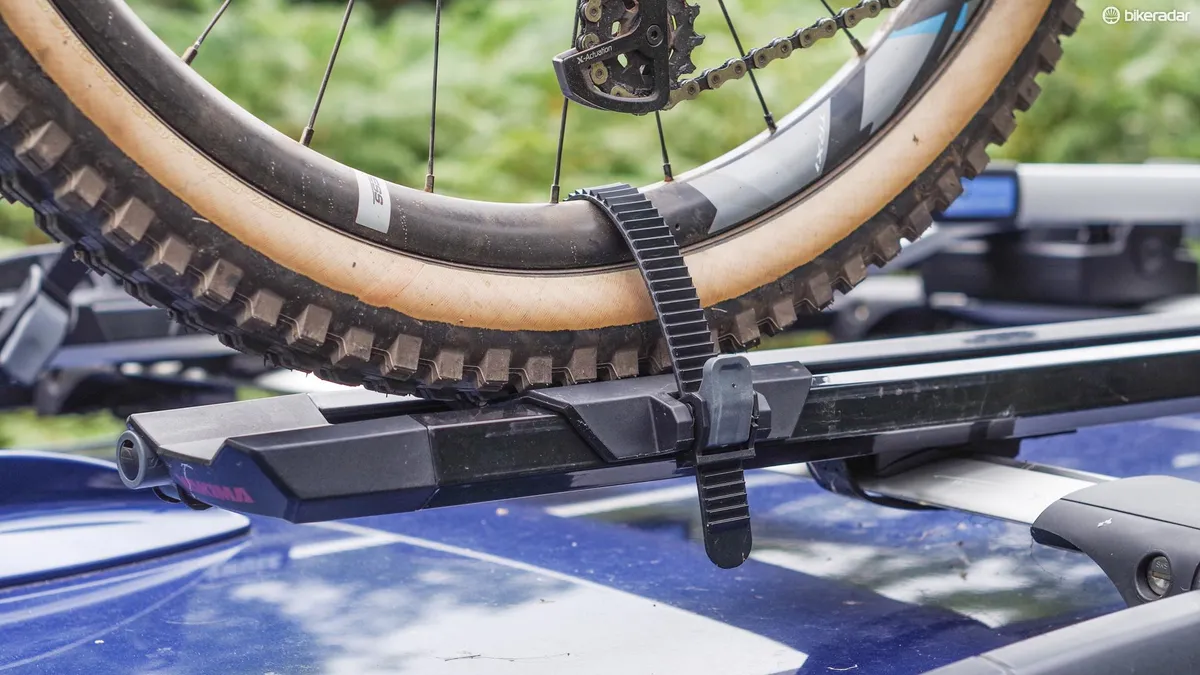The Yakima Highroad is a bicycle roof rack that attaches to roof bars, and which holds a bike by its wheels only, with nothing touching the frame.
Why roof rack?
There are lots of ways to transport bikes in or on your car but a decent roof rack is in some ways the most straightforward.
There’s no need to disassemble the bike, the risk of damage to your car's paintwork or interior is low, there are no issues with obscuring number plates, and it shouldn’t interfere with opening the boot or rear hatch if you position it far enough forward.

On the other hand, you do have to be mindful of clearance (e.g. in underground car parks), lifting bikes onto a car’s roof can be a challenge, and it’s almost certainly the least fuel-efficient way to schlep bikes around.
Taking the Highroad

Installing the Highroad is simple enough. It attaches to your roof bars using substantial straps which, once adjusted and locked down, are completely immovable.
The rack is made more secure by the addition of an SKS lock barrel, which Yakima sells separately in sets of four.
I fitted my test subject to Yakima’s own Whispbar Rail Bars which sit inside — rather than on top of — the factory roof rails on my car, but the universal-style mounting hardware of the Highroad means it will work pretty well with any cross-bars.
If you prefer, Yakima sells T-slot adapter kits that clamp the rack directly into the channel found on good quality bars.
Mounting a bike

Securing a bike to the Highroad is the work of about 30 seconds. You flip the front hoop of the Highroad up from its folded position, position the bike with its front wheel in the hoop, and then raise the rear hoop to trap the wheel.
A few turns (until it clicks) of the TorqueRight knob clamp the wheel in place, and then you simply secure the rear wheel to its tray using the ratchet-toothed strap. The tray slides fore and aft to accommodate different wheelbases.

The built-in cable lock adds a measure of security for pit stops on your travels. This takes the same style of lock barrel as the main attachment strap and isn’t usable without it.
Removing the bike is the reverse of mounting and it’s nearly as quick, although you’ll need to spend a few extra seconds unscrewing the knob to get the rear hoop to lie fully flat.
In the real world
I’ve used the Highroad for several months, leaving it permanently attached to the car and using it to transport bikes all over the place, including a drive from Gloucestershire to Edinburgh and back.
It’s been completely flawless in use and does not seem to have suffered any ill-effects from living outside full-time.
When there’s no bike mounted on it I forget it’s there because it doesn’t seem to add any extra wind noise and, despite seemingly relying on gravity to keep the wheel hoops flat, it doesn’t rattle over bumps.

On my setup the rack sits quite close to the roof of the car, and with low-profile road wheels the long rear wheel strap is liable to rub against paintwork. I solved this by shimming the strap with an ugly piece of cardboard, but a better solution is to buy a shorter strap — Yakima sells them separately for a few quid.
The other issue I encountered is that there is simply no way to use the Highroad to transport a bike with a full front mudguard (fender), because it relies on clamping the front wheel in place.
This is inherent to the design and there’s no way around it. If it’s an issue for you, you’d be better served by a fork-mount rack or one that holds your bike by its down tube.
It's better than the competition

The Highroad is quite expensive for a roof rack, but it’s extremely easy to use and well suited to transporting high-value bikes with paintwork you’re keen to protect.
Its principle competition is the similarly priced Thule UpRide which I've also reviewed. While the Thule has some key strengths (its rear wheel strap is slightly better and it fits a greater range of bike sizes), the Yakima is clearly the better rack overall. It's easier to live with and it's a more elegant design.
As long as the bikes you’re carrying don’t have a front mudguard, I’d recommend it.

